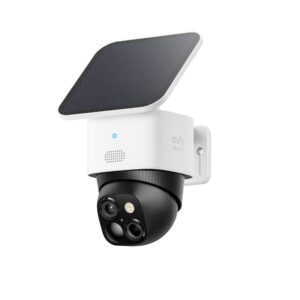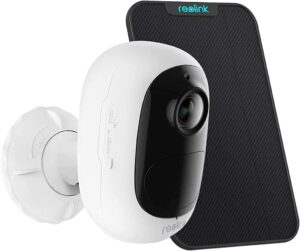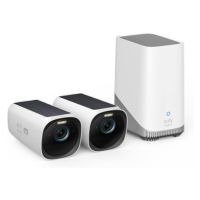We like the Reolink Argus 3 Pro for its simple DIY setup, cheap price tag, and easy-to-use app. You can pick up the camera and compatible Reolink solar panel for around $230, and it’s a snap to install. The Argus 3 Pro also has impressive solar power, a good picture, and clear starlight night vision. Whether you’re trying to go green, save money on the power bill, or keep an eye on a garage or pool area, this is a solid, affordable choice.
Best solar-powered security cameras in Australia (2025)
Best solar-powered security cameras
- : Best camera overall
- : Best pan/tilt
- : Best budget camera
- : Best design

Compare the best solar-powered security cameras
Price is accurate as of post date. Read full disclaimer.
1. Reolink Argus 3 Pro: Best solar-powered security camera overall
When it comes to affordable outdoor wireless security, the Argus 3 Pro delivers. This security camera is plug and play, and nearly every feature is customisable—from motion detector sensitivity to image resolution. In the app, you can configure the types of alerts and alarms you want and view a live video feed.
The camera also comes with two storage options: a micro SD card slot (card sold separately) or seven days of free cloud storage. If you add extra cameras or want more cloud storage, Reolink also offers plans that can support up to 10 cameras with 30 days of storage.
We also love that the Argus 3 Pro has an in-built spotlight which allows for colour night vision. If you don't think you need a spotlight, the Argus 2E (our budget pick below) is still an excellent—and slightly more affordable—choice.
2. Eufy Security S340 Solocam: Best pan/tilt solar security camera
The Eufy Security S340 Solocam isn't the cheapest solar-powered security camera around, but we reckon it's one of the best.
Not only does the included high-efficiency solar power mean you'll never have to charge the camera (provided it gets a couple of hours of sunlight each day), but its pan/tilt capabilities mean it offers unmatched coverage. It also has not one but two lenses (one ultrawide and one telephoto/zoom) which allow for some of the crispest security camera footage you'll ever see.
We're also a big fan of the fact that there's no hub, no monthly fees, and 8GB of included local storage. The only downside (other than the price) is that the only way to expand the local storage is to buy a Eufy HomeBase 3.
To learn more, read our full Eufy Security S340 Solocam review.
3. Reolink Argus 2E: Best budget solar powered security camera
For a solar-powered budget-friendly security camera, the easy-to-install Reolink Argus 2E has a lot of high-tech bells and whistles.
Some of our favourite features include the 10-metre range night vision (made possible by six infrared LEDs), two-way audio, and customisable sirens.
Another major selling point for this camera is that, like the newer Argus 3 Pro (our top pick above) has microSD card support and offers seven days of free cloud storage, meaning once you've bought the camera (and maybe a microSD card), that's all you'll have to spend.
EufyCam 3: Best solar security camera design
The EufyCam 3 is a recent addition to the Eufy Security lineup and the follow-up to the EufyCam 2 series. It offers unbelievable 4K resolution and each camera has an integrated solar panel, meaning you don't have to fiddle around with any wires.
On the downside, the EufyCam 3 only works with the HomeBase 3, so you'll need to get a starter kit that comes with one if you don't already have it.
Fortunately, with the HomeBase onboard, you also get 16GB of included local storage which is expandable up to 16TB. Furthermore, the HomeBase can act as a hub for your entire Eufy Security ecosystem, including video doorbells, motion sensors, and smart locks. Still, there's no denying it is a pricey package.
Looking for a new internet plan?
SafeWise recommends NBN 50 plans for households with security cameras, video doorbells and other smart devices. Here are the most popular plans right now from our sister site, WhistleOut.
Things to consider in a solar security camera
Placement
There are two things to consider when it comes to the placement of your solar-powered security camera. The first is where you want the camera to be installed for maximum protection, and the second is where the solar panel needs to be placed for maximum sun exposure.
To keep your solar-powered security camera up and running, you need enough peak sun hours to get it fully charged. Peak sun hours are classified as an hour in which the sun provides 1,000 watts of power per square meter. The measurement refers to the intensity of sunlight, rather than the amount of time the sun is shining.
Peak sun hours typically occur when the sun is at its highest point and can vary depending on season and location. Some guidelines to help you harness as much solar power as possible include placing your solar panel in a north-facing spot that gets full sunlight for at least six hours per day.
Depending on how long the cable is that attaches your camera to the panel, you might need to adjust your choice for camera placement. We recommend identifying your desired camera placement before deciding which solar camera to buy.
Weatherproof rating
When you count on an outdoor device to keep your home and family safe, you need to make sure it can stand up to the elements. Every outdoor solar camera we recommend has a weatherproof rating that lets you know how well it withstands dust and water.
Weatherproof, or Ingress Protection (IP) ratings, rank devices and device casing based on how much dust and water can get into the device.
Water standards
Water standards range from IPX0 that offers zero protection from water to IPX7 that means the product can withstand 30 minutes of submersion in up to one meter of water. There is an IPX8 rating that is defined by the manufacturer as better than IPX7.
Dust standards
Dust standards range from IPX0 that indicates no protection against dust and other objects entering the device to IPX6, which means the device is impervious to dust and other objects.
IP ratings are often displayed as IP65, which indicates the waterproof rating first (6) followed by the dustproof rating. If you see a rating with an X in the middle, that means the item is rated only for one factor.
Solar camera FAQ
Because home security cameras need to be on the job 24/7, they can use up a good chunk of electricity. You’ll definitely keep your power bill from taking an extra hit with solar-powered cameras, but the amount of savings will vary from home to home.
Most of the solar-powered security cameras we recommend include rechargeable battery backup that can keep your camera working for anywhere from 12 hours to six months, depending on use.







